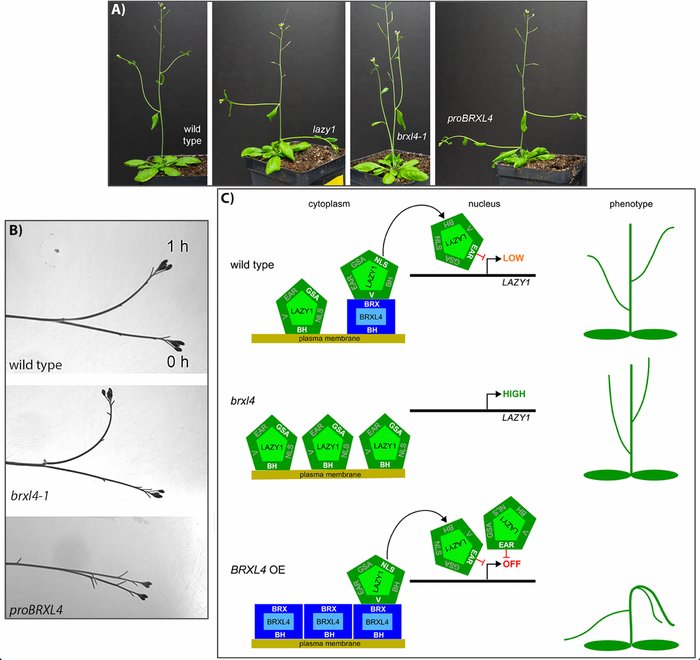TPJ Editor choice: It takes more than being LAZY: regulation of shoot branching angle by BRXL4
It takes more than being LAZY: regulation of shoot branching angle by BRXL4
Che, X., Splitt, B.L., Eckholm, M.T., Miller, N.D. and Spalding, E.P.
BRXL4‐LAZY1 interaction at the plasma membrane controls Arabidopsis branch angle and gravitropism. The Plant Journal (2022)
Plant root and shoot architecture is determined by the spatial arrangement of the organs. One determining factor of organ orientation is gravitropism. Plant organs sense gravity by starch-filled plastids, the statoliths, which sink as a consequence of gravitational force. This repositioning of statoliths triggers a signalling cascade, which leads to a rearrangement of auxin efflux transporters and thereby to a redirection of the auxin gradient and a differential growth of elongating cells, re-aligning the organs to the gravity vector. But how are gravity sensing, signal transduction and differential cell elongation connected?

Figure 1: LAZY1 and BRXL4 regulate the shoot branching angle in Arabidopsis.
A) Shoot branching phenotype of wild type, lazy1, brxl4-1 and BRXL4 overexpressor (proBRXL4) plants.
B) Wild type, brxl4 and BRXL4 overexpressing inflorescence stems just after a rotation to the horizontal (0 h) and one hour later (1 h).
C) Model for BRXL4 and LAZY1 mode of action. Figure adapted from (Che et al., 2022).
The proteins encoded by the LAZY genes are known to be involved in gravitropism signalling. They were named after their mutant phenotype, a prostrate growth of the main culm and tillers. Edgar Spalding, Professor of Botany at the University of Wisconsin, first started working with the LAZY genes when Takeshi Yoshihara came from Japan to work with him as a postdoc. For his PhD thesis, Takeshi had cloned the gene responsible for the lazy1 mutation in rice. Edgar Spalding’s lab had been focused on using electrophysiology to investigate mechanisms of rapid growth control, so the image analysis methods needed for measuring tiny Arabidopsis seedlings was already available in the lab and could be applied to study how the LAZY genes in Arabidopsis might control gravitropism. Spalding said, “All you need to study gravitropism is an Earth and a way to rotate a seedling!”
For their publication in The Plant Journal, Ximing Che, Spalding and colleagues set out to understand how LAZY1 functions in determining the shoot architecture. They identified BREVIS RADIX-like 4 (BRXL4) as interaction partner of LAZY1 at the plasma membrane. brxl4 mutant plants had a more upright shoot branching angle than lazy1 or even wild type plants, while overexpression of BRXL4 led to a branching angle close to horizontal (Figure 1A). The lazy1/brxl4 double mutant had a phenotype similar to lazy1, suggesting that BRXL4 acts negatively, and upstream of LAZY1. In response to horizontal rotation, wild type inflorescence stems turned upright and reached 45° after one hour, whereas brxl4 stems showed a hypergravitropic response and reached 90° after one hour. In contrast, the BRXL4 overexpressing lines showed a much weaker response to gravity and reached only 10° (Figure 1B).
BRXL4 expression pattern coincided with that of LAZY1 expression. LAZY1 expression was higher in brxl4 mutants than in wild type, while overexpression of BRXL4 reduced LAZY1 mRNA levels, suggesting that BRXL4 regulates LAZY1 expression. At the protein level, LAZY1-GFP localised to both the nucleus and the plasma membrane in wild type hypocotyls. In bxrl4 plants LAZY1-GFP had a stronger signal at the plasma membrane, while in BRXL4 overexpressors, LAZY1-GFP formed bright spots in the nucleus and accumulated in the cytoplasm.
The authors proposed a model for how LAZY1 and BRXL4 might regulate shoot gravitropism (Figure 1C): in wild type, the basic and hydrophobic (BH) domain of LAZY1 and BRXL4 facilitates protein localisation at the plasma membrane, where LAZY1 and BRXL4 act in the gravitropic signalling pathway. The interaction of LAZY1 with BRXL4 could make the LAZY1 nuclear localisation signal more accessible and thereby LAZY1 could partially localise to the nucleus. Accordingly, in brxl4 mutants, more LAZY1 can be found at the plasma membrane instead of the nucleus, thus more gravitropism-related signalling mediated by LAZY1 could occur and the shoots show a hypergravitropic response and more upright branches. In contrast, in BRXL4 overexpressing plants, LAZY1 predominantly accumulates in the nucleus, leading to a reduced response to gravity and lower branching angle.



